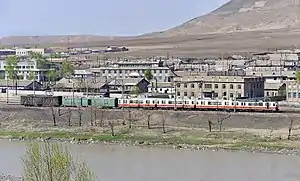Sambong 삼봉 | |||||||||||
|---|---|---|---|---|---|---|---|---|---|---|---|
 A 500 series EMU pulling a mixed train at Sambong station | |||||||||||
| Korean name | |||||||||||
| Hangul | 삼봉역 | ||||||||||
| Hanja | |||||||||||
| Revised Romanization | Sambong-yeok | ||||||||||
| McCune–Reischauer | Sambong-yŏk | ||||||||||
| General information | |||||||||||
| Location | Sambong-rodongjagu, Onsŏng, North Hamgyŏng North Korea | ||||||||||
| Owned by | Korean State Railway | ||||||||||
| History | |||||||||||
| Opened | 5 January 1920 | ||||||||||
| Electrified | yes | ||||||||||
| Services | |||||||||||
| |||||||||||
Sambong station is a railway station in Sambong-rodongjagu, Onsŏng County, North Hamgyŏng, North Korea, on the Hambuk Line of the Korean State Railway.[1]
History
Originally called Sangsambong station (Upper Sambong station), it was opened by the Tomun Railway Company on 5 January 1920, together with the rest of the Hoeryŏng–Sangsambong section of their line (Hoeryŏng–Tonggwanjin), which on 1 April 1929 was nationalised and became the West Tomun Line of the Chosen Government Railway.[2] It received its current name after Hasambong station (Lower Sambong station) was closed in 1933, making the "Upper" prefix redundant.
References
- ↑ Kokubu, Hayato. 将軍様の鉄道 (in Japanese). Shōgun-sama no Tetsudō. p. 93. ISBN 978-4-10-303731-6.
- ↑ Japanese Government Railways (1937). 鉄道停車場一覧 昭和12年10月1日現在 [The List of the Stations as of 1 October 1937] (in Japanese). Tokyo: Kawaguchi Printing Company. pp. 498–501, 504–505.
This article is issued from Wikipedia. The text is licensed under Creative Commons - Attribution - Sharealike. Additional terms may apply for the media files.